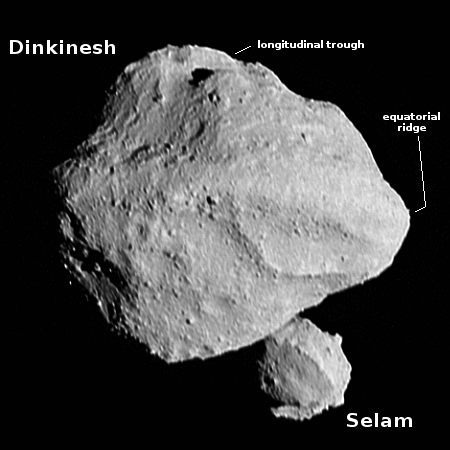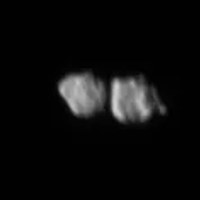Lucy’s first encounter with an asteroid produced surprises

At the 55th annual Lunar and Planetary Science Conference presently being held in Texas, the science team for the Lucy asteroid mission presented their first papers outlining what they learned during the spacecraft’s first asteroid encounter, flying past the main belt asteroid Dinkinesh on November 1, 2023.
To the right is the the best image taken at closest approach, at about 270 miles distance, annotated to include the analysis of Dinkinesh’s shape by scientists. As noted in the summary paper [pdf], the asteroid is about a half mile in diameter, and appears to have an equatorial ridge, similar to the ridges found on the near-Earth rubble-pile asteroids Bennu or Ryugu. Dinkinesh is not a rubble pile, however. Though boulder-strewn, it appears more solid, and even has what the scientists call a longitudinal trough, as indicated in the picture.
The ridge overlays the trough implying that it is the younger of the two structures. However, there is as yet no information to better constrain their relative ages, and thus they could potentially have formed in the same event. Indeed, Dinkinesh’s ridge and trough are likely the result of mass failure and the reaccretion of material, and may both be linked to the formation of Selam.
That flyby had produced one major surprise, the existence of a smaller satellite asteroid orbiting Dinkinesh, now dubbed Selam. It is shown in the lower left, as it appeared from behind the main asteroid as Lucy flew past. A later picture however revealed an even greater surprise.

The picture to the right is a close-up of Selam, taken about six minutes after closest approach from a distance of about 1,000 miles. To the shock of everyone, it turned out that Selam is a contact binary, apparently made of two objects fused together.
Selam consists of two near-equal sized lobes of ∼200 meters each [about 650 feet). It orbits Dinkinesh at a distance of roughly 3km [about 2 miles].
The solar system continues to prove a fundamental maxim: Once we get our first close look at any object, we always find that every single object is utterly unique, remarkably different from every other object.
Lucy is going to give us a lot more unique surprises, as its main mission to explore the Trojan asteroids that orbit the Sun in Jupiter’s orbit, sixty degrees fore and aft of the gas giant. It will do close-flys of nine Trojans from 2027 to 2029, after flying past another main belt asteroid in April 2025.
On Christmas Eve 1968 three Americans became the first humans to visit another world. What they did to celebrate was unexpected and profound, and will be remembered throughout all human history. Genesis: the Story of Apollo 8, Robert Zimmerman's classic history of humanity's first journey to another world, tells that story, and it is now available as both an ebook and an audiobook, both with a foreword by Valerie Anders and a new introduction by Robert Zimmerman.
The print edition can be purchased at Amazon or from any other book seller. If you want an autographed copy the price is $60 for the hardback and $45 for the paperback, plus $8 shipping for each. Go here for purchasing details. The ebook is available everywhere for $5.99 (before discount) at amazon, or direct from my ebook publisher, ebookit. If you buy it from ebookit you don't support the big tech companies and the author gets a bigger cut much sooner.
The audiobook is also available at all these vendors, and is also free with a 30-day trial membership to Audible.
"Not simply about one mission, [Genesis] is also the history of America's quest for the moon... Zimmerman has done a masterful job of tying disparate events together into a solid account of one of America's greatest human triumphs."--San Antonio Express-News

At the 55th annual Lunar and Planetary Science Conference presently being held in Texas, the science team for the Lucy asteroid mission presented their first papers outlining what they learned during the spacecraft’s first asteroid encounter, flying past the main belt asteroid Dinkinesh on November 1, 2023.
To the right is the the best image taken at closest approach, at about 270 miles distance, annotated to include the analysis of Dinkinesh’s shape by scientists. As noted in the summary paper [pdf], the asteroid is about a half mile in diameter, and appears to have an equatorial ridge, similar to the ridges found on the near-Earth rubble-pile asteroids Bennu or Ryugu. Dinkinesh is not a rubble pile, however. Though boulder-strewn, it appears more solid, and even has what the scientists call a longitudinal trough, as indicated in the picture.
The ridge overlays the trough implying that it is the younger of the two structures. However, there is as yet no information to better constrain their relative ages, and thus they could potentially have formed in the same event. Indeed, Dinkinesh’s ridge and trough are likely the result of mass failure and the reaccretion of material, and may both be linked to the formation of Selam.
That flyby had produced one major surprise, the existence of a smaller satellite asteroid orbiting Dinkinesh, now dubbed Selam. It is shown in the lower left, as it appeared from behind the main asteroid as Lucy flew past. A later picture however revealed an even greater surprise.

The picture to the right is a close-up of Selam, taken about six minutes after closest approach from a distance of about 1,000 miles. To the shock of everyone, it turned out that Selam is a contact binary, apparently made of two objects fused together.
Selam consists of two near-equal sized lobes of ∼200 meters each [about 650 feet). It orbits Dinkinesh at a distance of roughly 3km [about 2 miles].
The solar system continues to prove a fundamental maxim: Once we get our first close look at any object, we always find that every single object is utterly unique, remarkably different from every other object.
Lucy is going to give us a lot more unique surprises, as its main mission to explore the Trojan asteroids that orbit the Sun in Jupiter’s orbit, sixty degrees fore and aft of the gas giant. It will do close-flys of nine Trojans from 2027 to 2029, after flying past another main belt asteroid in April 2025.
On Christmas Eve 1968 three Americans became the first humans to visit another world. What they did to celebrate was unexpected and profound, and will be remembered throughout all human history. Genesis: the Story of Apollo 8, Robert Zimmerman's classic history of humanity's first journey to another world, tells that story, and it is now available as both an ebook and an audiobook, both with a foreword by Valerie Anders and a new introduction by Robert Zimmerman.
The print edition can be purchased at Amazon or from any other book seller. If you want an autographed copy the price is $60 for the hardback and $45 for the paperback, plus $8 shipping for each. Go here for purchasing details. The ebook is available everywhere for $5.99 (before discount) at amazon, or direct from my ebook publisher, ebookit. If you buy it from ebookit you don't support the big tech companies and the author gets a bigger cut much sooner.
The audiobook is also available at all these vendors, and is also free with a 30-day trial membership to Audible.
"Not simply about one mission, [Genesis] is also the history of America's quest for the moon... Zimmerman has done a masterful job of tying disparate events together into a solid account of one of America's greatest human triumphs."--San Antonio Express-News


Cue J.B.S. Haldane.
Truly amazing what exists “out there”! Let’s just hope it all STAYS “out there”!!
I really enjoy the variation of articles here – THANKS!!